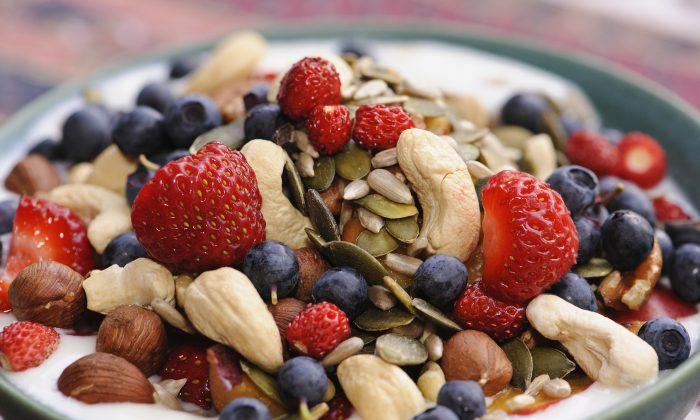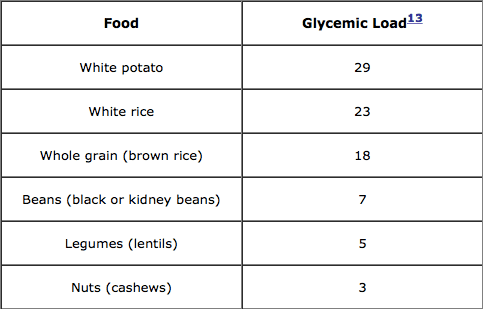Complications from diabetes result from constant elevations in blood glucose, which damage the blood vessels and other tissues. Excess glucose in the bloodstream results in the formation of Advanced Glycation End Products (AGEs)—products formed when sugars react with and consequently damage proteins or fats in the body’s tissues, especially the blood vessels. AGEs are produced at an accelerated rate in diabetes and contribute to complications such as impaired wound healing, diabetic nephropathy, and atherosclerosis. In addition to the AGE produced in the body due to excess glucose, some can also come from the diet. Fried foods, meats, and dry cooked starchy foods (roasted/fried potatoes, bread, crackers, cookies, muffins and other baked goods, cold cereals, etc.) are high in AGEs.
Lessening After-Meal Blood Glucose and Exposure to AGEs:
In designing a diet for type 2 diabetics, we aim to limit after-meal increases in blood glucose and to avoid dangerous AGEs by choosing major calorie sources with a low glycemic load (GL)—foods that provoke relatively small increases in blood glucose. An important point here is to choose high nutrient, low GL foods, not just any low GL food—this is where some conventional diabetes diets fall short:
- Meat is a low GL food, but higher meat consumption is associated with reduced lifespan and increased risk of developing type 2 diabetes; the diabetes risk is likely due to weight gain and AGE content. A diabetic diet emphasizing meat sacrifices long-term health for short-term glycemic control.
- Whole grain products and starchy vegetables. Whole grain intake is indeed associated with reduced risk of diabetes, probably due to fiber content. A low fat vegan diet emphasizing these foods in place of refined carbohydrates has shown some success with improving glycemic control. However, these diets tend to increase triglyceride levels (a risk factor for heart disease), and cooked grains and starches are not ideal calorie sources for diabetics because they still have a significant GL, as you can see in the table below:

Beans, and nuts (and seeds) are high in nutrients and low in GL, and are far more appropriate than grains and meat as major calorie sources for diabetics.
Beans and legumes are higher in fiber and resistant starch than whole grains, with a lower GL.
Regular consumption of nuts and seeds has well documented cardiovascular benefits, including cholesterol lowering, antioxidant activity, improved endothelial function, and reduced risk of sudden cardiac death and coronary heart disease.
In addition to reducing the risk of cardiovascular disease, nuts have a number of properties that make them a favorable food for diabetics:
- Nuts are a high-nutrient source of plant protein, fiber, antioxidants, phytosterols, and minerals.
- Nuts provoke a minimal glycemic response, which helps to prevent post-meal hyperglycemia, hyperinsulinemia, and AGE production. They also help to reduce the GL of an entire meal—almonds have been found to decrease glycemic and insulin response of a carbohydrate-rich meal while reducing oxidative stress.
- Nuts aid in weight maintenance—important since excess weight is the primary risk factor for diabetes. Despite their calorie density, greater nut consumption is associated with lower body weight, potentially due to appetite-suppression from healthy fats.
- Nuts have anti-inflammatory effects that may help to prevent insulin resistance
In a recent study HbA1C, an indicator of long term glycemic control, was measured in diabetics consuming either 2.5 ounces/day of mostly raw mixed nuts or an equivalent number of calories in a muffin—a cooked starchy food (the muffin had the same amount of fiber and calories as the nuts). HbA1C levels were lower in the nut group, suggesting long term protection from hyperglycemia when replacing carbohydrate foods with nuts.
This new data cements the results of previous observational studies that have found inverse relationships between nut consumption and diabetes. For example, the Nurses’ Health Study found a 27% reduced risk of diabetes in nurses who ate five or more servings of nuts per week. Among nurses who already had diabetes, this same quantity reduced the risk of heart disease by 47%.
Nuts are an important part of a diabetes-reversal diet, along with green vegetables, beans, and low sugar fruits. In a recent study on type 2 diabetics following this diet, we found that 90 percent of participants were able to come off all diabetic medications, and the mean HbA1c after one year was 5.8%, which is in the non-diabetic (normal) range. Nuts, seeds, beans, and vegetables not only keep glucose levels in check, but promote long term health as well.
In a study on type 2 diabetics following the diet-style I outline in The End of Diabetes, we found that 90 percent of participants were able to come off all diabetic medications, and the mean HbA1c after one year was 5.8%, which is in the non-diabetic (normal) range. All people with type 2 (and also type 1) diabetes should read this book. In the case of a type two diabetic, they could resolve their diabetes completely and in the case of a type one, they could reduce their insulin needs by more than 50 percent, which could prevent much suffering and a premature death.
This article was originally published on www.drfuhrman.com. Read the original here.








Friends Read Free